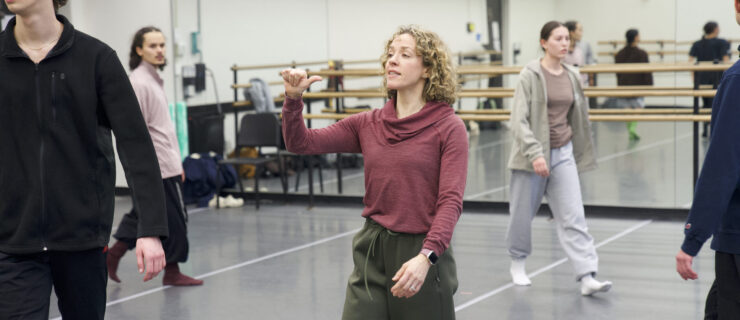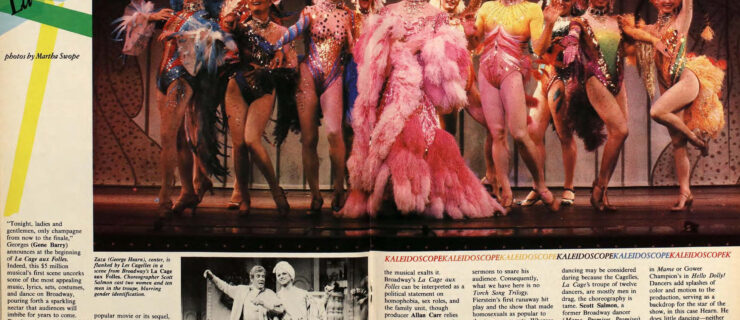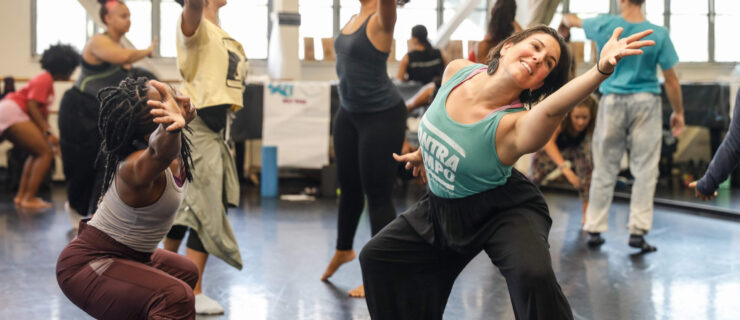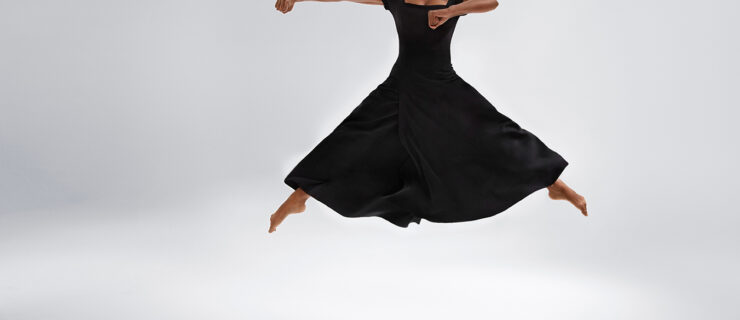Susan Marshall & Company
Susan Marshall & Company
Baryshnikov Arts Center, NYC
Performance reviewed: June 10, 2011
Photo: Kristen Hollinsworth in
Adamantine. Photo by Rosalie O’Connor, Courtesy BAC.
Susan Marshall & Company took over two performance spaces at BAC, June 9–11, for a celebration of its 25th anniversary season. The Howard Gilman Performance Space became a gallery for installation of five miniature works from 2006 and 2008 (under the title “Frame Dances”), created by Marshall in collaboration with her dancers. And in the Jerome Robbins Theater, Adamantine (2009) exposed and exploited the theater’s technical capacities.
Marshall’s strongest works have always been small duets, which use simple gesture to establish intimate, personal relationships. In “Frame Dances” three video screens around the room showed live dances, projected onto them, and previously recorded ones.
In the video-only Frame Dance, an excerpt from Cloudless (2006), five dancers squirm around in a tight, square box, filmed from above. In Sandstone (performed live) Kristen Hollingsworth and Joseph Poulson pursue the same idea, thrashing like frisky puppies in a four-foot-square sandbox, digging up buried stones, which they toss out of the box.
A dozen people slide and get pulled across a patch of Astroturf in Green, Green Grass. We watch the pedestrian mechanics of the live people, hauling and crawling on the floor and then watch them on screen, floating effortlessly, up and down, defying gravity.
Poulson, in Forward, spins upside down in a transparent, fog-filled cubicle. He rises and sinks on rigging by Flying by Foy. On video, he’s often invisible in the acrid mist, although live we can always see him, flailing in the smoky cell. This and Body of Water (seen only recorded)—where Luke Miller and Darrin Michael Wright bathe sensually together in a pool of milky liquid—don’t really transcend their mechanics, as the other two live pieces do.
Adamantine
melds dance, sound, and visual design into a series of provocative images in search of a unifying theme. The bare stage becomes a canvas for myriad effects of light and scenery by a crackerjack team (video design, projections, and scenic design by Jeremy Lydic; lighting by Mark Stanley). The kinetic sensibility is Marshall’s, but because she collaborates with her dancers in creating phrases, the vocabulary shows traces of the styles of other postmodern choreographers they dance with.
In the rich aural atmosphere, it’s hard to distinguish Jane Shaw’s sound design from Peter Whitehead’s score, which incorporates a few of his folk-rock songs, sung by him on guitar with drummer Elton Bradman.
Dancers’ silhouettes moving in a spotlight, projected on the rear wall, sometimes match the dancer onstage. Another large light lowers over a clump of dancers lying on the ground. Hollinsworth dances in its beam, and other dancers block it every time she falls down; we’re not sure which is cause and which effect.
Miller, Poulson, and Wright tangle, slapping each other’s bottoms. A spotlight circles the space, briefly catching ongoing motion, like a lighthouse beacon. An electric fan blows aloft clear plastic jackets that Hollinsworth puts on. Fluorescent and strobe lights catch her and Miller alternately frozen in tableaus and tussling on the ground.
A heavy plastic tarpaulin—black on one side, silver on the other— descends from the grid and slowly revolves, revealing and concealing the dancers’ action in a sophisticated game of peek-a-boo. A canvas sail drops into in an upstage corner, behind which there’s more playing with the fan. A white curtain falls behind Whitehead, singing on a rolling platform; the dancers rip it down. And in what’s lately become a common theatrical device, four lamps swing like random pendulums, as Petra van Noort nimbly cavorts amongst them before vanishing into the darkness.



